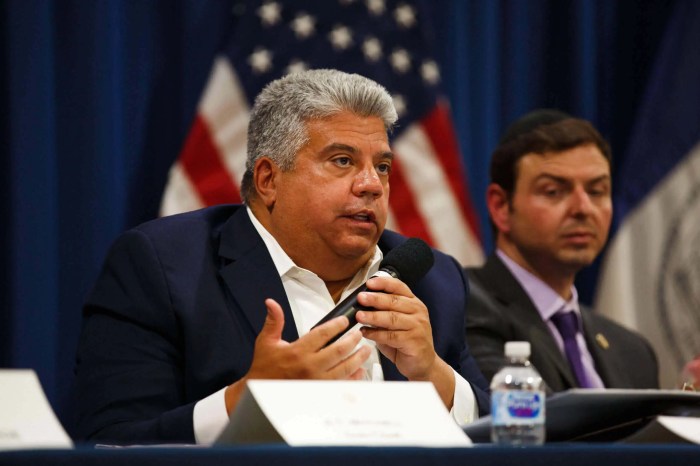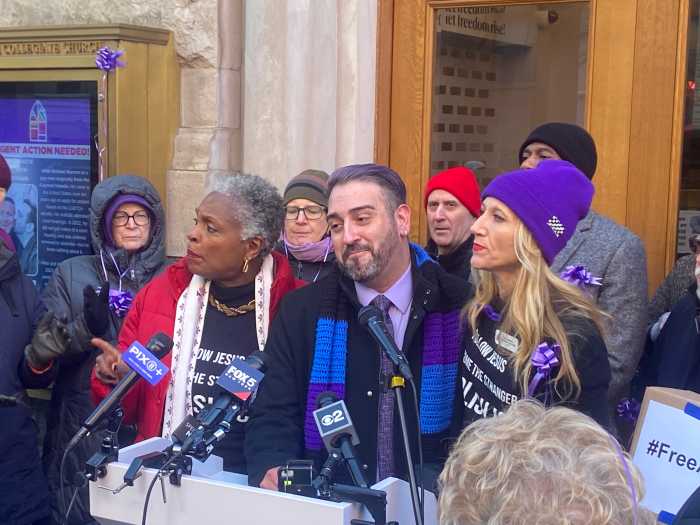An East Flatbush man who pleaded guilty to a 1986 killing to avoid prison after a successful appeal in 1996 had his wrongful conviction overturned Thursday, Brooklyn District Attorney Eric Gonzalez announced.
Brooklyn Supreme Court Justice Matthew D’Emic vacated Keith Roberts’ conviction and dismissed the indictment on Oct. 3 following a reinvestigation by the Conviction Review Unit (CRU). The CRU found that the sole eyewitness at trial was unreliable, Roberts’ rejected alibi defense was credible, and the police investigation was inadequate.
“This exoneration underscores the critical importance of our Conviction Review Unit and its mission to right the wrongs of the past,” Gonzalez said ahead of Roberts’ court appearance. “Mr. Roberts, like many others, found himself trapped by a system that failed to recognize his innocence, and nearly 20 years ago, he pleaded guilty just to stay out of prison.”
“Our reinvestigation revealed the deep flaws in the original case — unreliable testimony, overlooked evidence, and a rushed investigation. Today, we are able to restore his dignity and good name and affirm his innocence,” he continued.
Roberts, now 67, was previously convicted for the September 1986 fatal shooting of Pierre Sanon, 33, outside the Holiday Social Club in East Flatbush.
According to the only identifying witness, the shooter fled to a nearby house after the killing. Police went to the house, where Roberts lived, and interviewed him. He claimed to be at another party that night and voluntarily participated in a lineup, where the witness identified him.
Roberts was arrested, and the case was closed just over 12 hours after the homicide. At trial, the eyewitness testified, as did several witnesses supporting Roberts’ alibi. Despite this, the jury convicted Roberts of second-degree murder, and he was sentenced to 18 years to life. At his sentencing, Roberts maintained his innocence, and the victim’s family expressed their belief that someone else was responsible for the crime.
In 1994, the Appellate Division found Roberts’ alibi plausible and questioned the credibility of the eyewitness but upheld the conviction. A later-disclosed statement from another witness, claiming the shooter fled in a car, led the court to order a new trial, and Roberts was released.
In 1995, he accepted a plea deal for first-degree manslaughter, allowing him to avoid a retrial and remain out of prison. Roberts later sought the CRU’s help, asserting that he pleaded guilty only to avoid returning to prison.
“I promised my mother before she died that I would continue to fight to establish my innocence and honor her fight and sacrifice to free me and clear my name,” Roberts wrote to the CRU.
The CRU’s investigation revealed that the initial police investigation was inadequate and based on a single eyewitness account, which contradicted other witnesses who saw the shooter flee in a car.

The CRU also found that the eyewitness, who claimed he didn’t know the victim or the shooter, may have been the person who fought with the victim inside the club. Furthermore, the officer who conducted the investigation, her first homicide case, admitted to the CRU that once a suspect was identified in a lineup, the case was considered closed.
“Defendant’s manslaughter conviction should be vacated. After reviewing the entire record and interviewing material witnesses, CRU has concluded that based on the consistent and corroborated accounts of three eyewitnesses, there is a reasonable probability that defendant was not involved in the crime. Any consideration of retrying [the] defendant is untenable. Almost 30 years later, memories have faded, and witnesses cannot be found or have passed away. Accordingly, the indictment should be dismissed,” the CRU report concluded.
Roberts is the 40th person exonerated by Brooklyn’s CRU since its establishment in 2014, according to the National Registry of Exonerations. Earlier this year, Steven Carrington, 56, who was mistakenly identified as participating in a 1995 botched East Flatbush lumberyard robbery that resulted in a fatal shooting, had his wrongful homicide conviction overturned.
Separately in January, Steven Ruffin, who was just 18 when he was wrongfully convicted of the murder of a 16-year-old in 1996, had his name cleared following a CRU investigation.
Gonzalez said Brooklyn’s CRU’s work is recognized as a national model because of “our deep commitment to this work.”
“While that number represents lives changed and justice finally delivered, it also reminds us of the enormous responsibility we carry in the work we do every day,” he added.

























